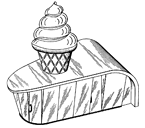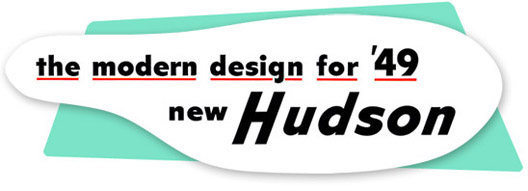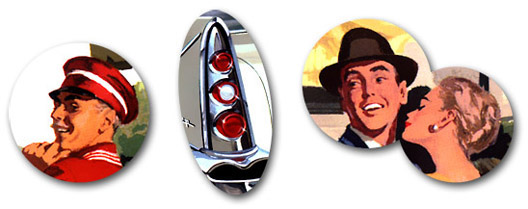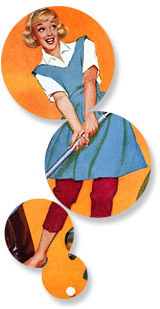FRIDAY, AUGUST 26, 2005
Commuting by train to and from work is part of the busy life of many of the dwellers in America’s larger cities. The designers for the future tell us that this may be the kind of train in which they’ll skim along the rails . . .
From 1946, another of Bohn Aluminum’s retro-futuristic fantasies.

MONDAY, AUGUST 22, 2005
Whenever you cook — in the back yard, in the woods, at the beach — keep S.O.S. handy for cleaning smoked-up utensils, greasy pans, spatulas. Barbecue chefs appreciate the magic help of S.O.S. — to clean burned-on food from barbecue grills, meat skewers, long-handled forks, grill spits . . .
The Russians were still five years away from Sputnik in 1952, but America had already perfected the barbecue kebab. (Also from the 1950s BBQ lab: A Sputnik-like experiment gone horribly awry.)
CHEERING ADDITION to any home will be this new Kroehler furniture. Its beauty is breathtaking, its comfort superb . . . because it’s Cushionized.
A Kroehler offering from 1946, when foam rubber was starting a revolution in home furnishings. If you grew up in Miami in the 1960s, these were the chairs you’d see in your grade-school teacher’s living room, if she was of a certain age. (Mrs. Knox? Mrs. Ilioff?)
SATURDAY, AUGUST 20, 2005
≈ When Your Stomach’s Feeling Dismal ![]()
When you’ve eaten, not wisely, but too well . . . and your stomach feels queasy, uneasy and upset . . . the situation calls for gentle treatment. Take soothing PEPTO-BISMOL. Three sizes at your druggist — or by the dose at his fountain. Listen to THE FAT MAN, Friday Nights, ABC Network.
An illustration from 1947 for Norwich Pharmacal, maker of Pepto-Bismol. Back before McDonald’s and Burger King, fast food meant the soda fountain or lunch counter at your local variety store. You could get a milkshake, Coke, hamburger, grilled cheese sandwich or BLT, and for dessert a banana split — and maybe indigestion. Now we learn you could top it all off with a shot of P-B. Who knew?

THURSDAY, AUGUST 18, 2005
S.O.S. has grease-removing soap right in it. Just dampen the pad and squeeze up the suds; that’s all you do. An S.O.S. pad is ready to go to work — instantly!
From 1956, another S.O.S. tableau by the little-known illustrator Haines Hall, this one featuring an early Volkswagen Beetle convertible. Textbook example of the girl being racier than the car.
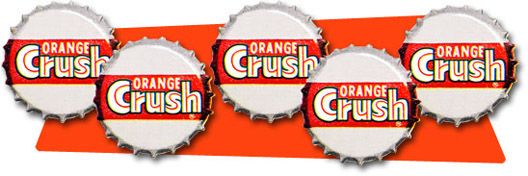
≈ Sip a Smile . . . Relax a While! ![]()
Whenever good food and good company team up — you’ll find refreshing Orange-CRUSH adding so much to those special moments of pleasure. Ice-cold, sunshine-bright Orange-CRUSH always leaves you with a smile of enjoyment . . .
Place: Suburbia, 1959. Occasion: Patio barbecue. Menu: Burgers, Orange Crush. Dress: Informal; lavender knee socks. BYO straws.
≈ Distinguished De Soto for 1953 ![]()
It is fitting that the 1953 De Soto should be the most beautiful ever — 1953 is De Soto’s Silver Anniversary! This distinguished new De Soto has an entirely new look . . . beautiful, glamorous, regal . . . with its attractive Air-Vent Hood, its huge one-piece curved windshield, its new low, graceful roof line, new long-flowing rear fenders . . .
| |
MONDAY, AUGUST 15, 2005
≈ Story of the Trains That Never Stop ![]()
There’s never a holiday for this Southern Pacific comet that streaks through the unfenced rainbow deserts of the Southwest. Practically every hour of every day, a Diesel locomotive like this one on the “Golden State” stays on the job . . .
From 1948, an illustration of the Southern Pacific Railway’s “Golden State” passing Picacho Peak, near Red Rock in Arizona. This ad, for Standard Oil of California, also features the RPM Delo pinwheel.
Continuing the train theme and also from 1948, a Haddon Sundblom illustration for one of the longest-running and most successful advertising campaigns ever.
Only once in a blue moon does a car step so far out ahead that it is a protected investment in motorcar value. You are invited to see just such a car — the New Hudson with “The modern design for ’49” — and for years to come! Here is truly streamlined beauty — a stunning combination of free-flowing, low-built lines that develop naturally out of a recessed floor which permits Hudson to build the lowest car on the highway — only five feet from ground to top . . .
Every time your eyes linger on a New Hudson, you are admiring beauty that is as genuine as nature at her glorious best! For this streamliner has fresh, modern styling that begins deep inside the car with a recessed floor which is the key to the “step-down” principle of design — the exciting idea that turns the corner of tradition . . .
The radically longer, lower, wider Hudson bodies introduced for the 1948 model year served as the basis for the company’s cars up to 1954, when it merged with Nash to form American Motors. The blue Custom Commodore illustrated is “pictured in the luxuriously modern Hotel Statler, Washington, D.C.” The 1,100-room Statler, finished in 1944 as the first large hotel of contemporary design in the United States, is now the Capital Hilton, at 16th and K streets NW. (Many thanks to Steve McMullen in California for providing the tearsheets that were used to make these images, just the tip of an ephemera iceberg he has generously loaned to the collection.)
WEDNESDAY, AUGUST 10, 2005
Like asparagus or absinthe, Noodles is an acquired taste.

≈ America’s Most Smartly Different Car ![]()
When you see it you’ll realize immediately that a thrilling new direction in modern automobile styling begins with the Chrysler New Yorker Deluxe for 1955. Call it what you will . . . “high fashion” . . . or just pure “good looks.” In either case this is not only the most beautiful of all Chryslers but the first regular production car to achieve all the slimness, tautness and feeling of motion that should be the natural marks of a fleet, land-borne vehicle. We call this new Chrysler styling the “100 Million Dollar Look,” and when you see this dramatically different motorcar you’ll readily understand why. Its breathtaking new beauty points the way for all cars to follow. It is long and sinewy and low: a sleek, clean length of steel that looks as if it might have been born in a wind tunnel. Inches lower in its sweeping silhouette. Washed free of clutter and knick-knacks. An exciting contrast to the square, boxy look of so many of today’s other big cars . . .
Virgil Exner’s 1955 lineup for the Chrysler Corporation was the opening salvo in a design offensive that would see the company’s product transformed from dowdy to daring, culminating in the radical “Forward Look” cars of 1957. The reference to “the square, boxy look” was an obvious dig at GM’s suddenly dated styling. The airbrushed photos that served as the basis for the illustrations in the New Yorker sales catalog gave the cars a luscious, candy-apple look.
≈ The Beautiful 1950 Chrysler Crown Imperial ![]()
Dramatically re-styled — the aristocrat of cars. Here luxury finds its most beautiful expression. The Chrysler Crown Imperial Limousine stands alone. A classic. New inside and out — the car of supreme good taste. And its all-new beauty superbly reflects the sound and inspired engineering and the solid comfort inside. The headroom, legroom and shoulder-room for which Chrysler is so justly famous! The full vision all around!
The disc brakes on Chrysler’s early-1950s eight-passenger sedans marked a first for full-size American cars. The artwork is by Frederick Siebel, known at the time mainly for fashion illustration.
No detail has been overlooked in creating for the Firedome series appointments of unerring good taste. Here is a comfortable graciousness which reflects today’s trend toward the informal, for elegance without ostentation . . .
Good morning, class. Today’s lesson: Detroit automotive nomenclature, circa 1958. The Big Three > Chrysler Corporation > DeSoto. The DeSoto came in three “series”: Firesweep, Firedome and, at the top, Fireflite. (Firesweep, the price leader, had a an odd-looking front end based on the cheaper Dodge.) Each series offered some or all of a variety of body types: Station wagons, sedans, hardtops, convertible. “Hardtop,” short for “hard-top convertible” (don’t ask), denoted a body style without pillars between the front and back doors (or, in coupes, between the front and back windows). DeSoto hardtops all carried the “Sportsman” designation. So you could have a DeSoto Firedome Sportsman, Firesweep Sportsman, etc. Station wagons, available in the Firesweep and Fireflite series, were dubbed either “Shopper” (six-passenger) or “Explorer” (nine-passenger, with a rear-facing third seat), available in 1957 with two or four doors, and in 1958 as four-door models only. In total, sixteen different models that were really four body-style variations (station wagon, convertible, coupe, sedan) of the same car. Never mind that the entire Chrysler lineup of five brands was basically the same car. Or that the entire Big Three constellation of models was, with minor variations in wheelbase, width and length (excluding Thunderbird and the Corvette), basically the same car: Six places, 17 to 19 feet long, about 80 inches wide. By 1960, Ford, Chrysler and GM were finally offering “compacts,” and the Edsel and DeSoto were doomed.
Value leader of the De Soto line for 1958, the new Firesweep gives you true big-car luxury for a surprisingly modest price. Breathtaking exterior beauty, glamorous interiors and all of De Soto’s exciting new engineering advances are yours in the highly popular De Soto Firesweep — priced just above the very lowest.
Here we see illustrated that age-old romantic triangle of man, car and woman (or, depending on how you connect the dots, doorman). Can you say “garage à trois”?
≈ 1958 Explorer with Vista-Seat ![]()
DeSoto 9-Passenger Explorer: Here’s the newest idea in station wagons — the popular rear-facing Vista-Seat. Plenty of room for three adults, and the kids love it, of course! One-piece tailgate with power-operated roll-down window. One hand does it!
In 1958, Explorer, Voyager and Villager were nameplates familiar to millions, but they were on station wagons (DeSoto, Mercury and Edsel, respectively) rather than minivans and SUVs, which were still many years in the future. This illustration takes us back to the days of glass soda bottles, cloth caps and orange sand.
≈ The Exciting Look and Feel of the Future ![]()
A truly magnificent automobile, this 1958 De Soto — long, low and completely beautiful, with a lithe look of forward motion that can only hint at its extraordinary performance. Only one thing is missing to complete the picture — you, behind the wheel . . .
What? You say you don’t collect old car literature? The 1958 DeSoto dealer brochure is an excellent place to start.



